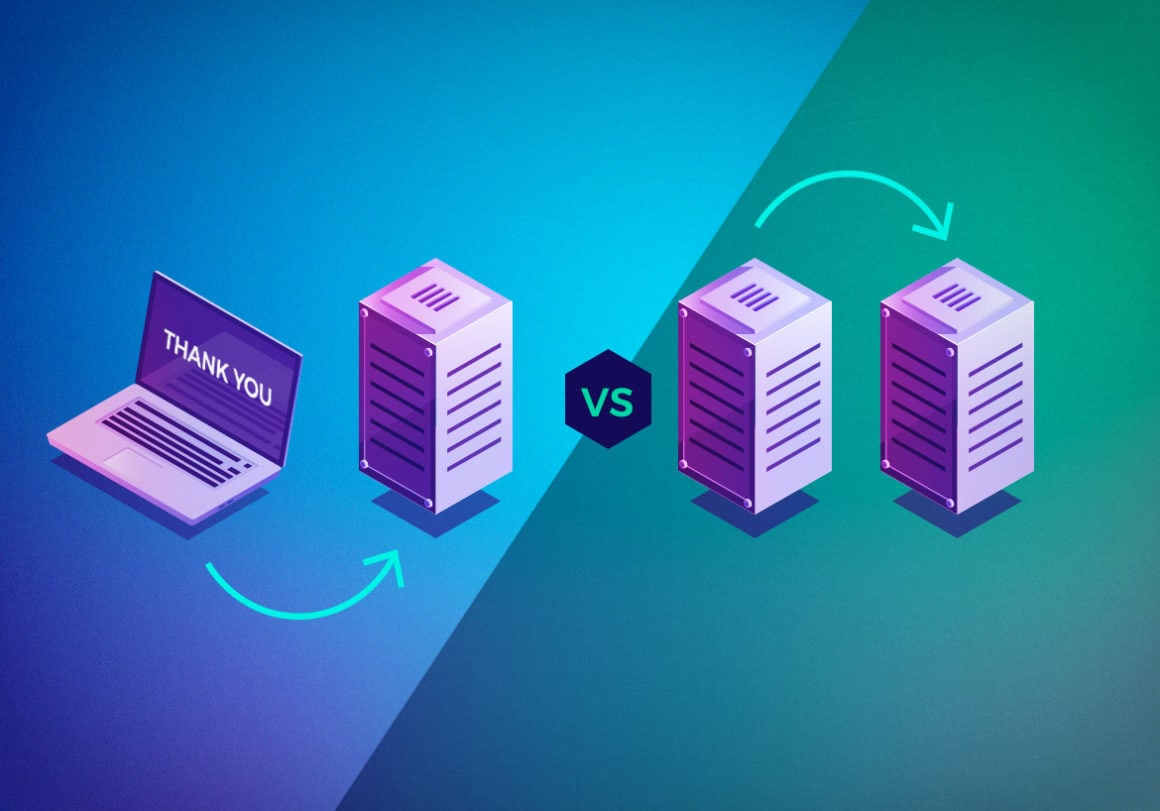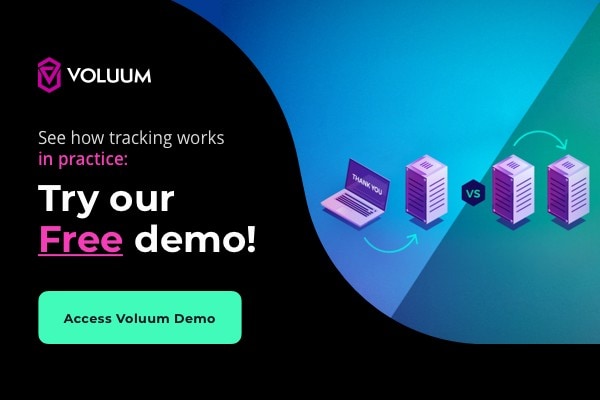Conversions are the measure of your success: everything else simply leads to this point. So accurately measuring the number of conversions is crucial in any digital marketing or ecommerce store venture. The step up is attributing these conversions to original visits. Both steps require an outstanding tracking solution.
We at Voluum take tracking really seriously. To accomodate for different scenarios and use cases, Voluum supports two main methods for tracking conversions – Tracking Pixel and S2S Postback URL.
Postback URL tracking and a tracking pixel essentially cover all cases. But for some affiliate networks, a third method is available, API integration; this however varies by affiliate network platforms. While all three are possible with Voluum Tracker, the most popular methods though are by pixel and Postback URL.
No banner with provided ID foundUnderstanding the differences between these two options will help you choose the most suitable method for your needs.
But firstly, let’s ask and answer: why would you even want to track conversions?
Conversion attribution
Conversion tracking is essential for conversion attribution. Attribution allows you to connect a specific visit (and with it, a concrete ad variation, landing page and offer) with a resulting conversion.
Knowing this allows you to optimize by learning what works, and adjusting your message, campaign funnel and advertising strategy towards a more cost-effective approach.
Conversion attribution is the cornerstone of an efficient marketing strategy. Without it, the only thing affiliate marketers are left with is watching numbers shift without the knowledge of why something is working or not.
If you don’t feel entirely confident in your marketing skills – or maybe reading all the technical terms in this article are making you dizzy – I have a suggestion. Take a second to check out our Affiliate Academy by Voluum. Our free courses go from beginner to experienced… but Course 2 covers all tracking methods with videos, reading materials and even quizzes to make sure you’re really learning. But if you’re feeling confident, then let’s just keep going. 
To make conversion attribution possible, the ad tracking software Voluum assigns unique IDs to each click on the ad of an offer from an affiliate network. Then, Voluum stores this information to connect different touchpoints of a campaign funnel. These click IDs are then passed to the affiliate network and returned upon conversion. Voluum then matches the click ID that came with a conversion from the affiliate network with the one behind an original click to attribute this conversion to a correct event.
The results are clear and consistent reports allow you to take a deep dive and discover what is going on with your affiliate links, landing pages, conversion data and ad campaigns.
Now, let’s find out together what kind of conversion tracking system is better to use for conversion attribution – pixel or Postback URL tracking, so in other words… Let’s see who is going to win this clash of giants!
Conversion Tracking Pixel
A Tracking Pixel is a small script that runs when a web page is loaded. It allows users to track webpage visits, ad impressions, conversion data, and other types of online activities. It is generally considered easier to use than a Postback URL, however it comes with many limitations that we’ll get into later.
A tracking pixel is an HTML piece of code that can be placed on a landing page or offer page to track the visitors’ actions.
In order to use a tracking pixel for tracking conversions of your offers, you need to place the tracking pixel on a confirmation or a thank-you page. This method is best for offer owners because, usually, only they can directly edit the confirmation page code to add the Tracking Pixel. Another situation could be if a marketer works directly with their partner who provides the offer; this is another case where the Tracking Pixel tracking method can be implemented.
When a user visits the confirmation page, your ad tracking software – for example, Voluum – will be able to register a conversion for that specific ad and campaign, thanks to the tracking pixel code.
How? We are able to place (and later read) the cookie with a unique click ID value that identifies a user along the campaign funnel. This cookie is placed in the user’s browser when the ad is clicked.
As you can see, tracking your offers with a tracking pixel is very straightforward and does not require a complex, technical, savvy process. It also does not involve any tracking links from an affiliate network platform.
Conversion data tracking with a pixel is simply placing a piece of code on the page right after a conversion happens. And the job of the affiliate marketer is done.
Pros:
- A conversion tracking pixel is your ultimate solution when you don’t have many technical resources and you own the “thank you page” (meaning that you don’t buy media on behalf of any 3rd party);
- It is simple and quick to implement, effortless to use, so you don’t need to be a tech expert – you can start tracking right away;
- It is a matter of just copying the pixel from Voluum and pasting it into the code of the final thank you page that a user sees after the conversion has happened. Simple as that.
Cons:
- Pixels are cookie-dependand, what makes them less reliable. For example, if the user cleared their browser cookies between clicking on a link on a landing page and the actual conversion, this conversion simply won’t be tracked.
- Apple implemented Intelligent Tracking Protection 2.0 on Safari which prevents websites from being able to track users’ browsing habits without their permission. Right now, a website can request tracking privileges, but the user has to specifically opt-in. Even if the user agrees for tracking in Safari, unless they interact with that particular website over the period of 30 days all data and cookies will be permanently deleted. All in all, pixel tracking can get pretty difficult on Safari and iOS in general; there are also issues with this method on other browsers in this OS.
- Additionally, Google announced that their web browser, Chrome, will stop supporting 3rd party cookies from 2023. This will also cause problems for pixel tracking. Luckilly, we already have a solution for that! In short, our solution uses 1st party cookies that are not going away anytime soon. Stick with Voluum to always be futureproofed.
Postback URL Tracking
Postback URL Tracking is also known as server-side or Server-to-Server (S2S) tracking. Using Postback URLs is usually considered more secure in today’s privacy-centered online environment. The Postback method of tracking is usually used by affiliate networks and other 3rd party offer providers (as opposed to the Tracking Pixel which is favored by affiliates who own their offer).
If you choose this method, a click ID value is generated and sent to your affiliate network via HTTP request when a user visits the offer. A click ID value is a unique value that Voluum generates and passes to an affiliate network using URL parameters (parameters supported by the affiliate network for this purpose).
Later, when a conversion happens, the affiliate network passes this value right back to Voluum by generating a psotback request. Once this action is completed on the part of the affiliate network, you will be able to see a conversion in your reports. Having received the value of click ID, Voluum is then able to recognize the exact visit and attribute the conversion to the right campaign.
That’s Postback tracking. Simple, right?
Pros:
- Using S2S Postback URLs is a more secure and reliable method to count conversions, thus it is highly recommended to use whenever you can.
- S2S Postback URLs ensure accurate tracking and stats gathering. This type of tracking doesn’t depend on cookies, so it works even if a visitor has cookies blocked on their web browser. For this reason, Postback URLs are considered one of the most trusted tracking methods.
Cons:
- Postback URL tracking has to be supported by your affiliate network. However, for affiliate marketing, a tracker and affiliate network go hand-in-hand. It is highly recommended to invest your time, money and efforts into advertising with affiliate networks that support Postback tracking so that you have the correct conversion data.
- With other trackers, you would also have to set up appropriate Postback URL parameters and tracking tokens to accurately pass information. Luckily Voluum has a Postback URL template for all major affiliate networks that contain all parameters and tokens already set up and a Postback URL ready to submit to your affiliate network. You can learn more about Postback URL tracking from our knowledge base.
Postback URL and Affiliate networks
How do Postback URLs from affiliate network platforms work in detail?
When a user clicks on affiliate ads, they are redirected to a campaign funnel which is recorded in an affiliate marketing software like Voluum Tracker. Voluum generates a unique click ID for this visitor and passes it to the affiliate network within the offer URL, in the parameters supported by the given affiliate network.
Then, the affiliate network grabs this conversion value and saves it on their side. When a conversion happens, the affiliate network fires the Voluum Postback URL which includes the click ID in its parameters.
That is how Voluum is informed of the conversion value: by knowing the Click ID, Voluum is able to assign it to a specific visit.
Affiliate networks and affiliate marketers both need to be aware of how many conversions occur to be able to make payouts and receive affiliate payment.
For an affiliate marketer, this information is also essential so they can be aware, with the help of affiliate tracking software, what aspects of their advertising is working and what isn’t. They find out about conversion value and trackable personal data regarding that conversion. Without accurate data on their advertising, affiliates have no way to optimize campaigns and landing pages to increase profits.
Hey, what about the API method mentioned before?
That’s right, there is a third method of tracking conversions and it is based on the ad tracker’s API integration with an affiliate network.
This turns our competition into a three-way duel.
A truel.
This is the most reliable method of conversion tracking, as it happens at the back-end of both platforms. No messy processes. When a conversion happens, the affiliate network’s infrastructure pings an ad tracker with all necessary information.
However, as this solution requires a lot of development work on both sides, it is not very prevalent in the affiliate marketing landscape.
Pros
- The most reliable method of passing conversion, fool-proof and secure. Doesn’t need cookies to work.
- It is a “set-and-forget” solution. Once you perform an integration, you don’t have to set anything up, conversions will be passed on along with additional information, such as payout.
Cons
- It is rarely used, as it requires a lot of effort to be developed, mostly on the side of the given affiliate tracker or affiliate network. Once it is developed and ready however, it’s a breeze for the affiliate marketer to implement on all their offers.
You will be glad to hear that Voluum uses the API integration for conversion tracking with Clickbank. Read the document that describes the Clickbank integration if you want to learn more.
Clash Of Giants – Who’s best for the affiliate marketer?
By now you should have a fairly good understanding of what the two main tracking methods are and how they work.
Now it’s time to choose the best method for your own business needs. As I said at the very beginning, tracking is fundamental if you want to become successful in affiliate marketing, so make sure you do it right. Or, try out our platform with the Voluum demo. It’s free!
In the end, you are not the one making a choice, you simply adapt to your scenario. Affiliate networks don’t support pixels and your own offers don’t have a postback solution. So the thing defining your conversion tracking solution is the thing you are advertising. The important thing is:







2 comments
Hi dear,
thank you for writing this article,
I found that is helpful.
Hello,
I see no clear winner here. Seems both are used for different purposes as you have described in your article.
Conversion Pixels are used when you are promoting your own offer on your website, while S2S Postbacks are used in the case of third party offers or offers from affilaite networks.